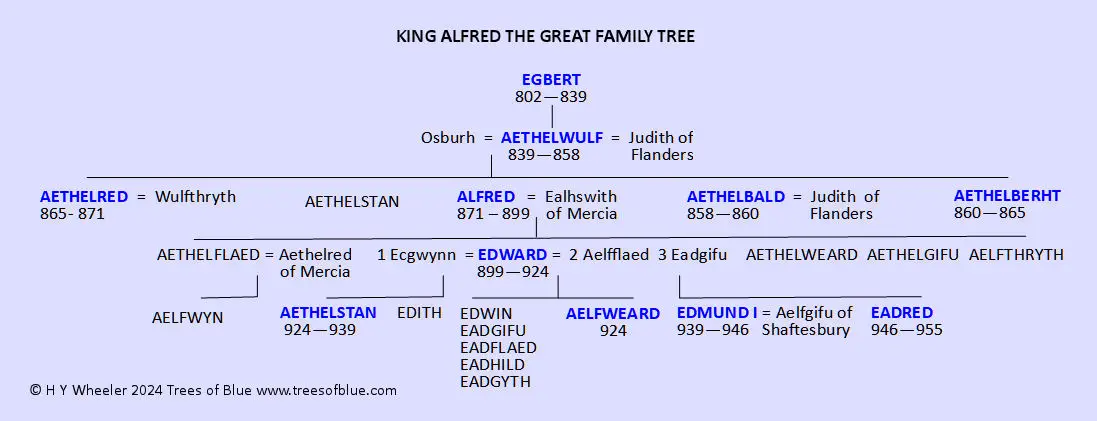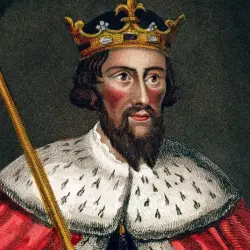King Alfred the Great was a member of the House of Wessex. He was the fifth son of King Aethelwulf and succeeded his brother Aethelred as King in 871. Aethelred’s two sons, were considered too young to rule at a time when Wessex was constantly fighting off Viking raids.
Contents
King Alfred the Great Family Tree Image
King Alfred the Great Family Tree in Table Form
King Alfred the Great Short Biography
King Alfred the Great Family Tree Image showing:
grandparents, parents, siblings, wife, children and grandchildren

King Alfred the Great Family Tree in Table Form showing:
grandparents, parents, siblings, wife, children and grandchildren
GRANDPARENTS
Paternal Grandfather – King Egbert – (770 – 839)
SIBLINGS
King Aethelstan of Kent – (d. 852)
Aethelswith – (838 – 888)
King Aethelbald – (d. 860)
King Aethelberht – (836 – 865)
King Aethelred – (847 – 871)
MARRIED
Ealhswith of Mercia – (d. 902)
CHILDREN
Aethelflaed of Mercia – (870 – 918)
King Edward (the Elder) – (874 – 924)
Aethelgifu – (d. 896)
Aethelweard – (d. 920)
Aelfthryth of Wessex – (877 – 929)
GRANDCHILDREN
By Aethelflaed
Aelfwyn – (c 888 – c 950)
By Edward the Elder and Ecgwynn
King Aethelstan – (895 – 939)
Edith – (d. 930)
By Edward the Elder and Aelfflaed of Mercia
Eadgifu – (902 – 955)
King Aelfweard – (904 – 924)
Eadflaed – (b. 905)
Edwin of Kent – (d. 933)
Eadhild – (d. 938)
Eadgyth – (910 – 946)
By Edward the Elder and Eadgifu of Kent
King Edmund I – (921 – 946)
King Eadred – (923 – 955)
Edburga – (d.960)
by Aelfthryth
Arnulf I of Flanders – (c893 – 964)
Adelolf of Boulogne – (c910 – 960)
Ealswid – (dates not known)
Ermentrud – (dates not known)
Alfred the Great Short Biography
Early Life
King Alfred the Great was born in 849, the fifth son of King Aethelwulf of Wessex and Osburh at Wantage, Berkshire. Alfred was not expected to become King since he had four elder brothers. In 853 he was taken to Rome to be confirmed by the Pope and it is likely that he was being prepared for a life in the Church. He made a second trip to Rome two years later with his father.
Succession of Alfred’s Brothers
Alfred’s eldest brother, Aethelstan, had died in 852, so when King Aethelwulf died, Alfred’s brother, Aethelbald became King. Aethelbald had no children so his unmarried brother Aethelberht succeeded. He was followed by the next brother, Aethelred.
In 866 the Great Heathen Army invaded Britain. This began a period of continual battles between the Danes and the Anglo-Saxons. In 871 King Aethelred was badly injured at the Battle of Meretum and died of his injuries on 15th April 871. Aethelred had two children, Aethelhelm and Aethelwold but they were considered too young to take the throne and the crown passed to Alfred.
King of Wessex
Wessex continued to be repeatedly attacked by the Vikings. In 872 Alfred paid them off but they soon returned and demanded further payments. In 877, the Archbishop of Canterbury complained that Alfred was using church money to pay off the Vikings. After the Viking force devastated Chippenham, Alfred lost the support of the Witan and fled to the Somerset marshes.
Alfred and the Cakes Legend
The ‘Alfred and the Burnt Cakes’ legend stems from this period. Alfred was taken in and given shelter by a peasant woman who did not know he was the king. She asked him to watch some cakes for her, but he was so taken up with his thoughts about how to defeat the Vikings that the cakes were burnt.
The story may have some truth and Alfred and his family may well have been taken in by a peasant family who had no idea who he was. Equally likely is that the story is an allegory for Alfred’s situation. He had been so absorbed in trying to pay off the Vikings that he had not fully realised the extent to which he had lost the support of the Witan. He may even have been overthrown by a coup.
Whatever the truth of the story, Alfred did not give up or exile himself. Instead, he formulated a plan to regain his place as King and began rallying local militia.
Alfred’s Return
In 878 Alfred defeated the Viking force at the Battle of Edington. The Viking leader Guthrum was forced to accept baptism and peace terms. The Treaty of Wedmore established the Danelaw, a region including the Midlands and East Anglia that was controlled by the Vikings. The peace lasted until the death of Guthrum in 890.
During the 880s, Alfred the Great constructed a number of burghs (fortified towns) to make future Viking attacks more difficult. He also ordered that ships be built to attack Vikings before they could land.
Later Years
Alfred the Great was a learned man and liked to be in the company of educated men and in 891 started the Anglo-Saxon Chronicle to record the history of England.
In 892 a large force of Danes invaded. King Alfred reached an agreement with one of the leaders, Haesten, but the Viking did not honour the agreement and lay waste to Benfleet. Nevertheless by 896, Alfred supported by his son, Edward had pushed the Vikings back and they had given up attacking Wessex.
Although Alfred was only King of Wessex, it was his dream that eventually one King would rule all of England. This dream would eventually be realised by his grandson, Aethelstan.
Alfred the Great died in 899 and was succeeded by his son King Edward the Elder.
Published April 22nd 2022 – Updated – Dec 4 2024
Harvard Reference for King Alfred the Great Family Tree:
Heather Y Wheeler. (2022 – 2025). King Alfred the Great Family Tree & Biography (849-899). Available: https://www.treesofblue.com/king-alfred-the-great-849-899. Last accessed June 14th, 2025

